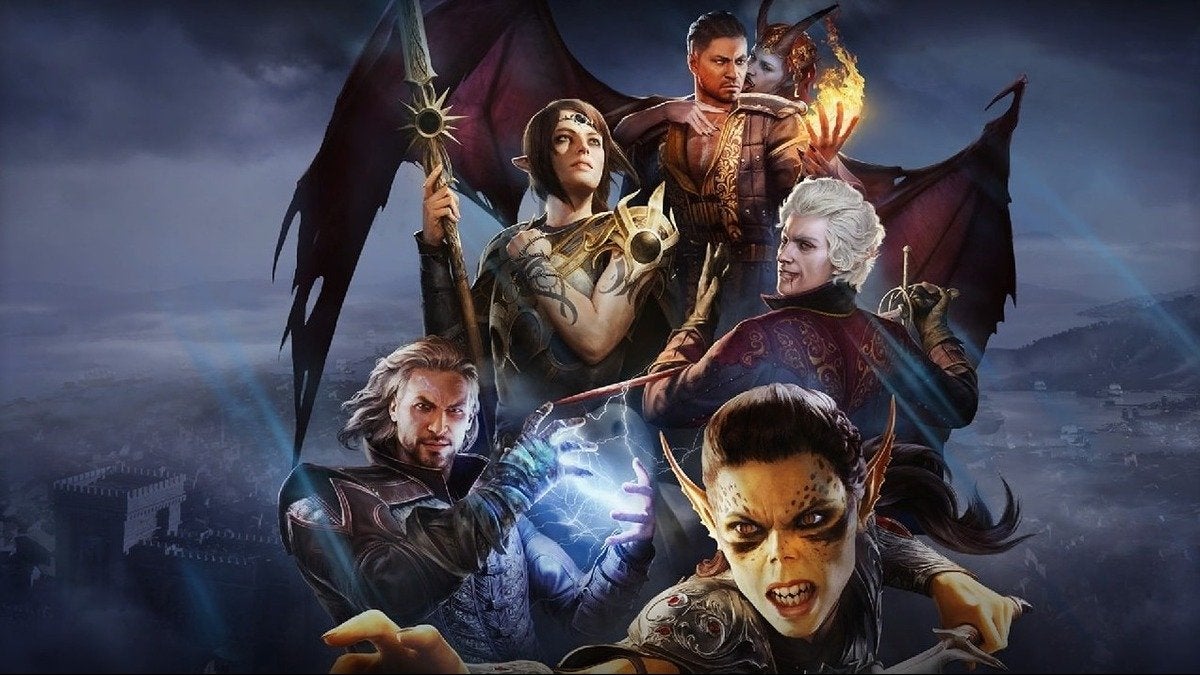![]() Key Takeaway
Key Takeaway
Baldur’s Gate 3 gives players 12 classes and 46 subclasses to choose from, each with their own mechanics, strengths, weaknesses, and lore. Multiclassing is also available—making it possible to merge classes to create more unique and powerful combinations.
You can change your class at any time by speaking to Withers: an NPC that appears in your camp during Act 1. This requires 100 gold pieces and can be done as many times as you like during your playthrough.
For new players, we’d recommend choosing Barbarian or Fighter for those prioritizing brute strength. For those wanting to use magic, Cleric and Druid offer flexibility on the battlefield, as well as unique lore.
Before diving into this humongous world, consider using a class and subclass guide in Baldur’s Gate 3. With 12 classes and 46 subclasses to choose from, character creation isn’t easy. It all depends on your aesthetic preferences, your play style, and what traits you value most—be they strength or smooth-talking.
Table Of Contents
About Classes and Subclasses in Baldur’s Gate 3
After likely spending too much time designing the character of your dreams, you’ll be tasked with choosing a class for your adventurer in Baldur’s Gate 3. The class you choose will impact many areas of the game, including your abilities in battle, the dialogue options you’ll have at your disposal, and the Features available to you. Features include things like weapon and armor proficiencies—as well as bonus spell slots for magic users.
You can also select a subclass for your character. Certain subclasses can be selected immediately, while others require you to reach a certain level to unlock. As you become stronger, you’ll learn new abilities based on your class while also reaping the special benefits of your subclass.
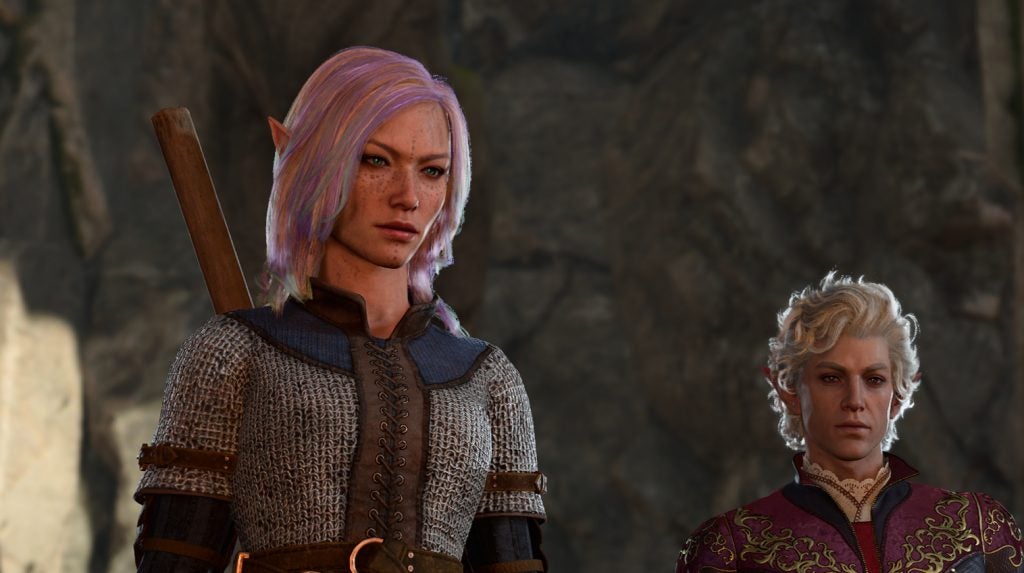
Any race of character can choose any class, but certain races have unique qualities that make them a good fit for a certain class. For example, Gold Dwarves make great Paladins because of their toughness, while Wood Half-Elves are particularly well-suited to stealthy classes.
The game’s story will mold itself around the class you choose. Certain quests and interactions will only be open to certain classes, making each subsequent playthrough very different.
About Multiclassing
In the full version of Baldur’s Gate 3, players can mix and match multiple classes to better optimize their character. This is known as Multiclassing, and it has been a staple in the world of Dungeons & Dragons for years.
Selecting a secondary class is simple. Once available, click on the level-up button for your character. On the level-up screen, you’ll see a button at the top right of the Level Up window labeled Add Class.
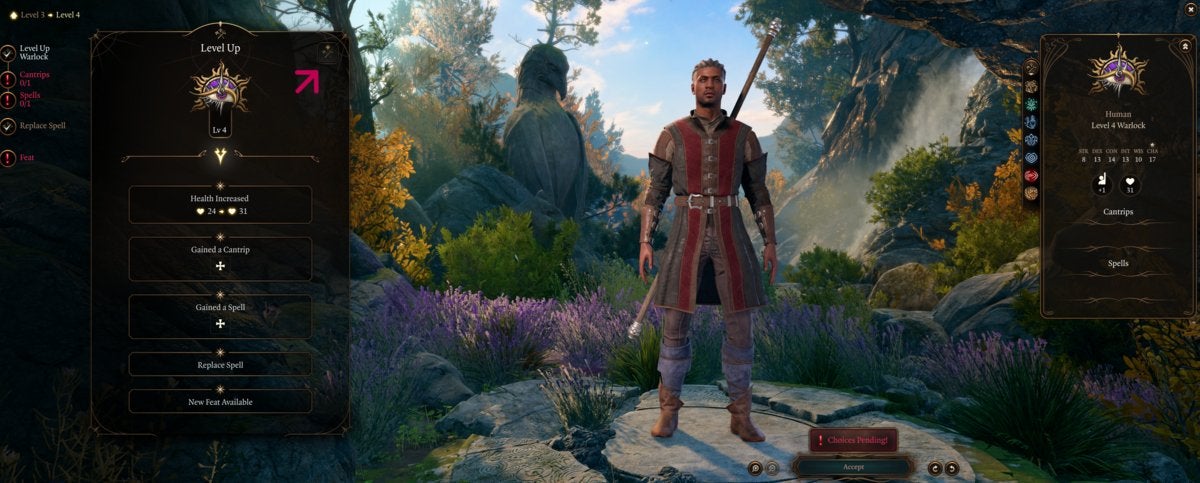
There are no stat requirements for Multiclassing, and any character can select any secondary class. Note that you won’t automatically gain the proficiencies granted by your secondary class, and each class will level up separately.
All Classes and Subclasses
Below, we’ve compiled all classes and subclasses for easy perusal. This includes each class’s primary ability, weapon and armor proficiencies, subclasses, and the recommended races for each.
Barbarian
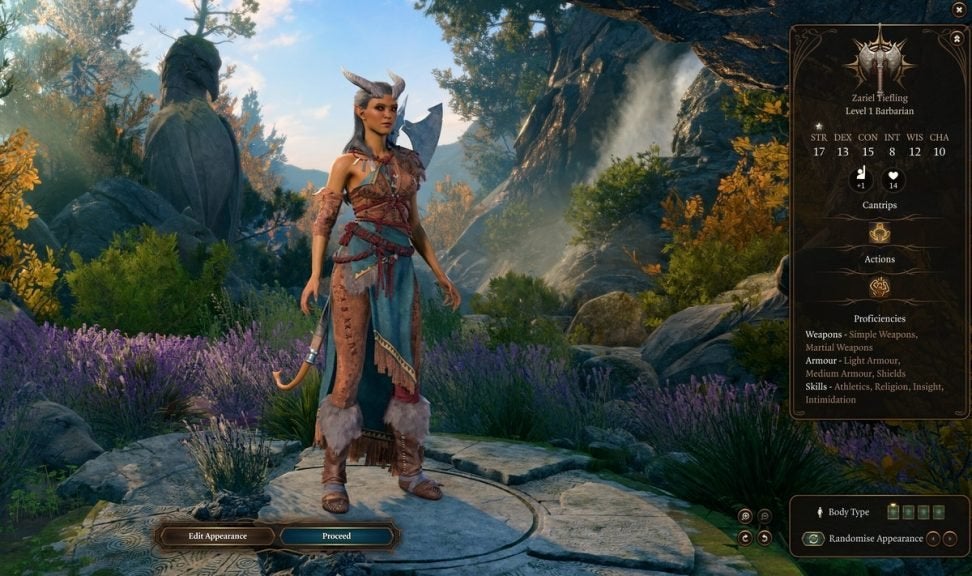
- Primary Ability: Strength
- Recommended Races: Gold Dwarf, Half-Orc, Human
- Weapon Proficiencies: Martial Weapons, Simple Weapons
- Armor Proficiencies: Light Armor, Medium Armor, Shields
- Subclasses: Berserker (Level 3), Wildheart (Level 3), Wild Magic (Level 3)
Barbarians are powerful and ferocious warriors who excel on the front lines. This melee class is a good choice for players who want a straightforward approach to battle. By tapping into their Rage, Barbarians can amplify their damage output while resisting incoming attacks. They are also proficient with many different weapons. On the flip side, Barbarians are vulnerable to magic and have poor range.
The Berserker subclass has enhanced strength and resistance and is also able to Intimidate, cheat death, and frighten enemies at higher levels. Mindless Rage also grants immunity to fear, charms, and calm emotions. This is a great choice for players wanting more simplicity and raw power.
The chaotic Wild Magic subclass causes a random magical effect to activate during your Rage. This can either be a boon or a detriment to your party—so beware. We’d recommend that more skilled players choose this challenging subclass.
Players wanting more versatility will enjoy the Wildheart subclass, which allows you to commune with nature to take on the power of a specific animal. You can choose to have the heart of a bear, eagle, elk, tiger, or wolf, with each granting you a unique ability and stat boost.
Bard
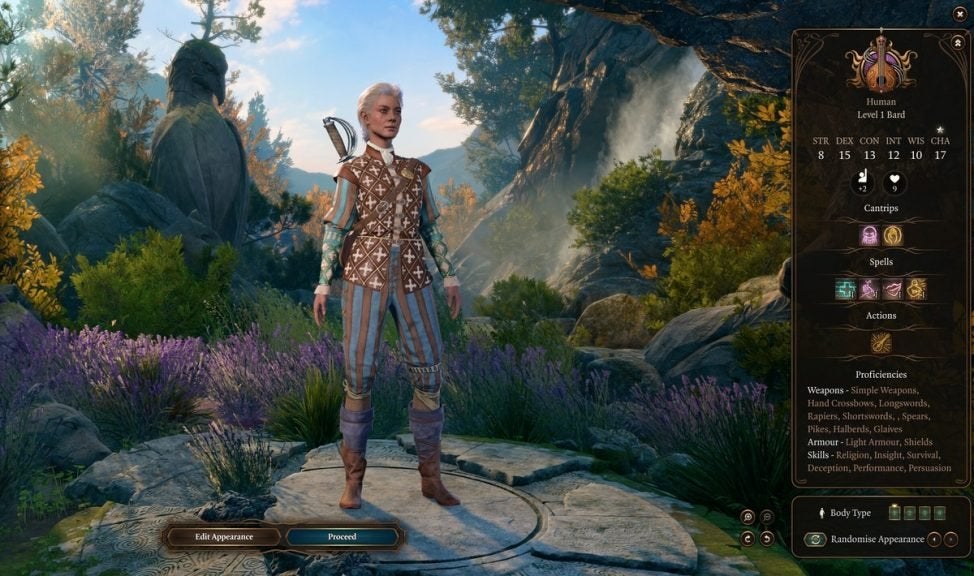
- Primary Ability: Charisma
- Recommended Races: Drow Half-Elf, Human
- Weapon Proficiencies: Hand Crossbows, Longswords, Rapiers, Shortswords, Simple Weapons
- Armor Proficiencies: Light Armor
- Subclasses: College of Lore (Level 3), College of Swords (Level 3), College of Valor (Level 3)
A musician may not seem like the most useful class in a fight, but don’t be fooled—Bards are also well-versed in the arcane. As they play their songs, they cast spells that can empower their friends and harm their enemies. Given their skill at sweet-talking, Bards are also able to pass most skill checks with ease. Quirky and fun, players choosing Bard as their starting class should be prepared to heal and buff their way to victory.
Unfortunately, the damage output of a Bard is typically low, and the class is very Concentration heavy.
With Bard Colleges across the land, you’ll be able to pick your alma mater once you hit Level 3. Those from the College of Lore are obsessed with history and knowledge, ready to charm the masses with tales of old. The Lore subclass grants proficiency in Arcana, as well as Intimidation and Slight of Hand. You’ll also be able to use the Cutting Word Reaction Skill: a helpful debuff to reduce attack rolls, Ability Checks, and attack damage.
Those graduating from the College of Swords don’t only serenade crowds with song, they are experts in swordplay. Players who hope to be in the thick of battle will benefit from the versatile Swords subclass which transforms your Bard into a self-sufficient DPS fighter. After immediately gaining access to six new Martial skills, you’ll also be granted Scimitar proficiency and Medium Armor proficiency.
The College of Valor inspires its graduates to keep the memory of great heroes alive. The Valor subclass grants Medium Armor and Martial Weapons proficiency, as well as Shields proficiency. Players can expect bonus attack power and additional survivability in the thick of things.
Cleric
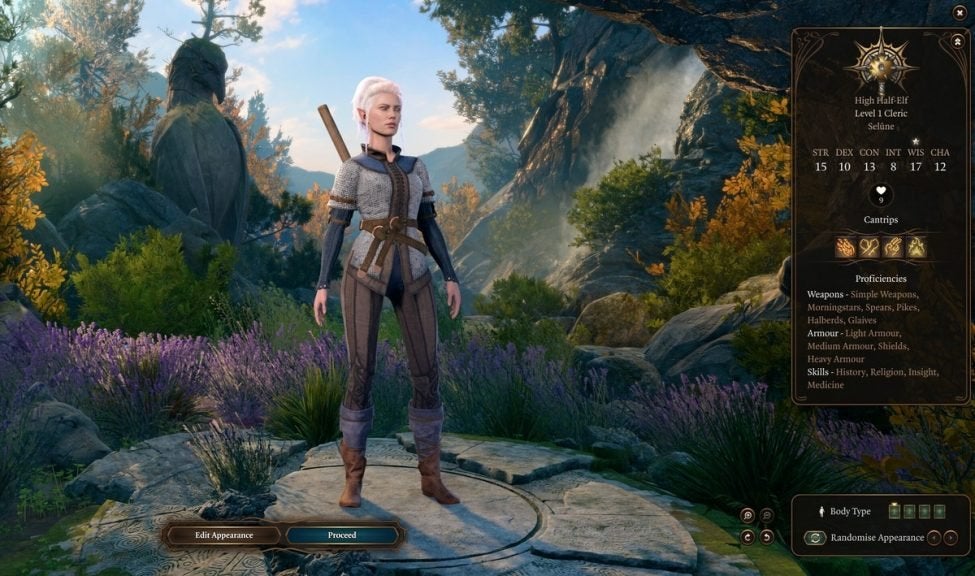
- Primary Ability: Wisdom
- Recommended Races: Gold Dwarf, Human, Half-Elf
- Weapon Proficiencies: Morningstars, Simple Weapons
- Armor Proficiencies: Light Armor, Medium Armor, Shields
- Subclasses: Knowledge Domain, Life Domain, Light Domain, Nature Domain, Tempest Domain, Trickery Domain, War Domain
Clerics are powerful spellcasters that excel at both healing and offensive spells with minimal sacrifice. Although they have a small repertoire of spells early in the game, Clerics have high survivability and growth potential over time.
When creating your Cleric, you’ll also be asked which Deity your character worships. The Deity you choose will also have a reputation in the world of Baldur’s Gate 3 and may impact how certain NPCs interact with you. Only Clerics get to choose a Deity, so roleplayers may want to give this class a try.
Unlike many other classes, Clerics choose their subclass—or Divine Domain—immediately. The Domain you choose will impact the type of Spells and Channel Divinity actions you’ll have access to, so choose wisely.
The Knowledge Domain is perfect for story-heavy players. This subclass allows you to learn two additional languages at the start of the game and offers a choice of proficiency in two of the following: Arcana, History, Nature, or Religion. Any related skill checks will see a +4 bonus.
If your main focus is keeping yourself and your party members alive, the Life Domain is a good choice. This subclass focuses on protective and restorative spells while also adding Heavy Armor proficiency. It also permanently buffs all healing spells by 2 HP.
Clerics worshipping a Deity of Justice will gravitate towards the Light Domain. Choosing this subclass allows you to dispel darkness, making it particularly useful against the undead. Light Domain Clerics are granted the Burning Hands and Faerie Fire spells, along with the always handy Light Cantrip.
If you were on the fence between Cleric and Druid, the Nature Domain was made for you. These spellcasters can learn any Druid Cantrip of their choosing and can also gain proficiency in Animal Handling, Nature, or Survival. Like Light Domain Clerics, they can also wear Heavy Armor.
The offense-heavy Tempest Domain focuses on lightning and thunder, allowing its users to wear Heavy Armor and use Martial Weapons. Clerics wanting to stand on the front lines would be at home in this Domain, which allows for massive damage to be dealt.
Those following the Trickery Domain gain advantages in Stealth checks and can disguise themselves on a whim. If they feel particularly mischievous, they can also make use of the Charm Person spell for some dastardly deception. Stormheart, one of the first friends you meet in Baldur’s Gate 3, is a Trickery Domain Cleric.
Clerics hoping to smite their enemies with Holy power would feel welcome in the War Domain. These spellcasters can use Martial Weapons, wear Heavy Armor, and perform extra attacks as early as Level 1. Players looking to Multiclass into something more melee-focused later in the game would find this a good choice.
Druid
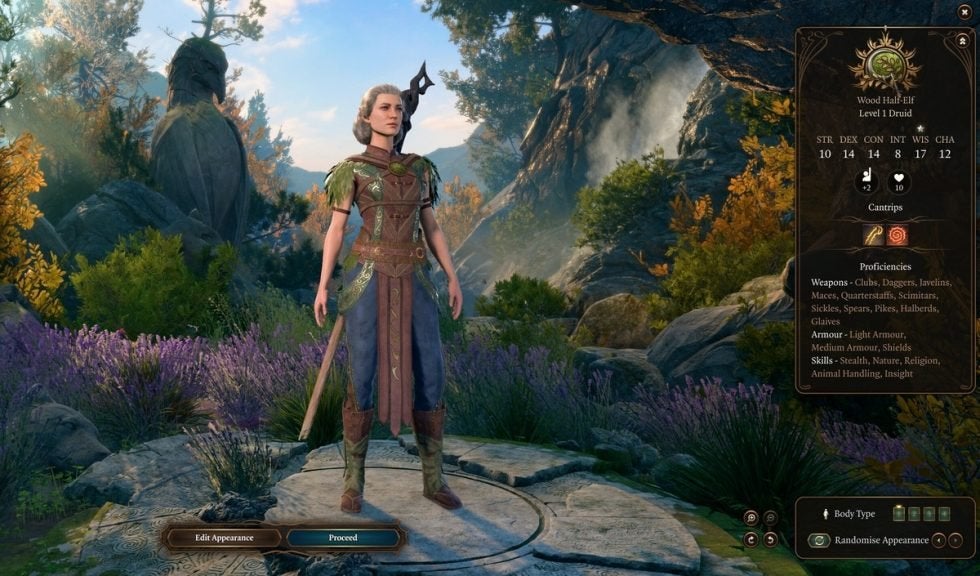
- Primary Ability: Wisdom
- Recommended Races: High Elf, Human, Wood Elf
- Weapon Proficiencies: Clubs, Daggers, Javelins, Maces, Quarterstaffs, Scimitars, Sickles, Spears
- Armor Proficiencies: Light Armor, Medium Armor, Shields
- Subclasses: Circle of the Land (Level 2), Circle of the Spores (Level 2), Circle of the Moon (Level 2)
Druids are spellcasters that share a special bond with nature and all manner of living creatures. At Level 2, they can select a Druid Circle subclass that will impact which animals they can transform into, along with other bonuses. While transformed using Wild Shape, Druids will have an entirely different HP pool and are able to deal massive damage. Outside of shapeshifting, Druids have access to powerful offensive and defensive spells.
Circle of the Land Druids connect to the neverending energy that runs through the Earth and they are able to transform into a Spider, a Badger, a Cat, or a Wolf. This subclass grants the highly sought-after Class Action Natural Recovery, which is used to recover spell slots. It’s also a versatile choice, as Circle of the Land Druids can easily mix and match spells from different environments.
Circle of the Spores Druids can also transform into a Spider, a Badger, a Cat, or a Wolf, but find beauty in decay rather than life itself. These powerful spellcasters are able to cast multiple spells in a single turn and can summon spore-covered zombies, making them a force with which to be reckoned.
Along with the standard Spider, Badger, Cat, and Wolf transformations, Circle of the Moon Druids can also shapeshift into a mighty Bear. A number of buffs and passives are available to shapeshifted Druids in this Circle, and the Lunar Mend ability allows for powerful healing.
Fighter
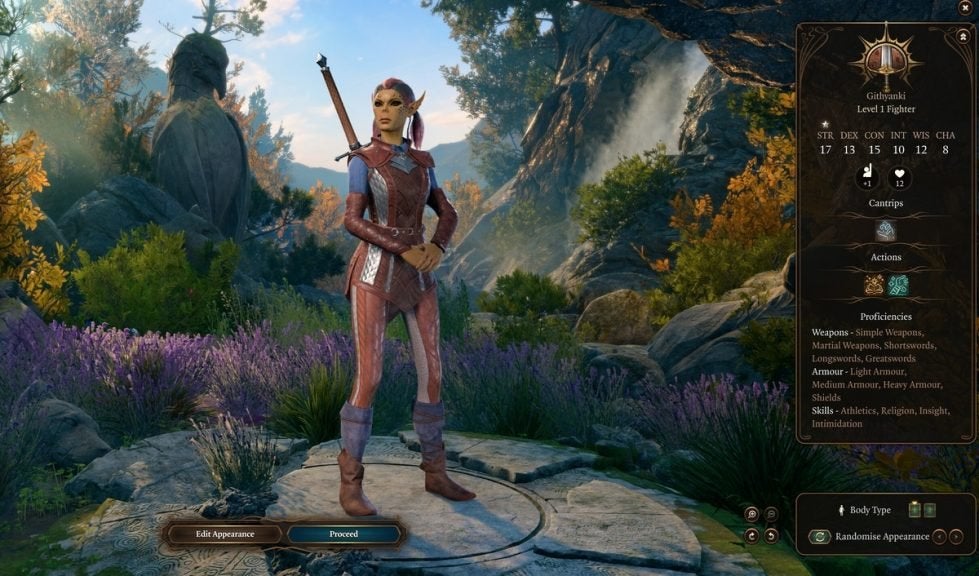
- Primary Ability: Strength
- Recommended Races: Gold Dwarf, Githyanki, Half-Orc, Human
- Weapon Proficiencies: Martial Weapons, Simple Weapons
- Armor Proficiencies: Light Armor, Medium Armor, Heavy Armor, Shields
- Subclasses: Battle Master (Level 3), Champion (Level 3), Eldritch Knight (Level 3)
If you’re looking to jump into the fray right away, the Fighter class is easy to learn and straightforward. It’s a great class choice for beginners, as these durable tanks can deal plenty of damage from the get-go while also mitigating incoming attacks. Fighters can use a variety of weapons and have access to powerful buffs to make their attacks even more potent.
The Battle Master subclass transforms your Fighter into an expert tactician, able to access powerful moves to turn the tide of any onslaught. These warriors can command other party members to retaliate after being attacked and can inflict fear on their enemies. They can also access strength-boosting buffs and gain additional HP at will.
Fighters choosing the Champion subclass focus on raw damage, boosting their Critical Hit stat to the max. Champions don’t gain access to any unique skills, but players who want to smash their way to victory without juggling too many moves will enjoy this blunt upgrade.
If you’d like to add a pinch of magic to your skillset, the Eldritch Knight subclass grants access to three Level 1 Wizard Spells. This includes the tried-and-true Magic Missile, allowing your Fighter to deal damage from across the battlefield.
Monk
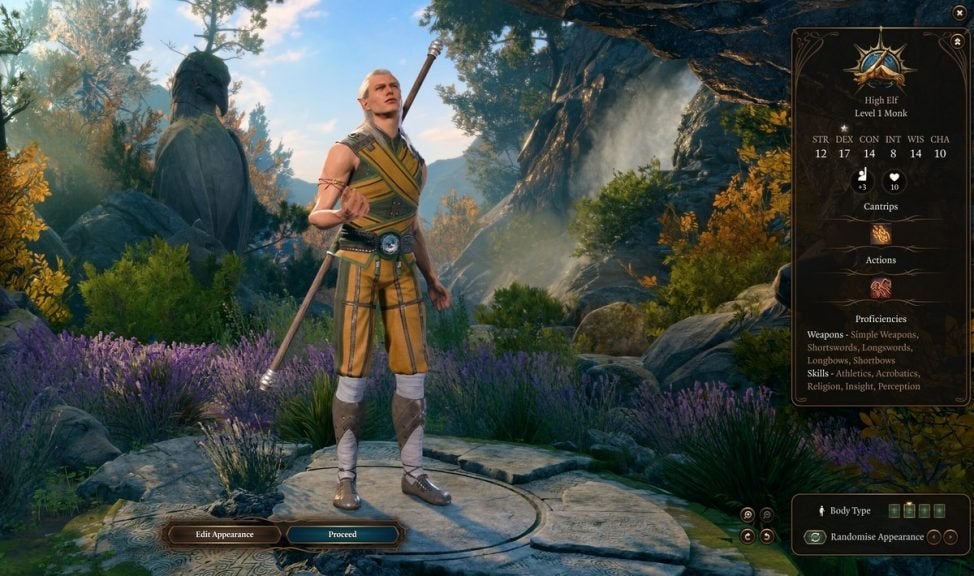
- Primary Ability: Dexterity/Wisdom
- Recommended Races: Drow, Half-Orc, Wood Half-Elf
- Weapon Proficiencies: Shortswords, Simple Weapons
- Armor Proficiencies: None
- Subclasses: Way of the Four Elements (Level 3), Way of the Open Hand (Level 3), Way of the Shadow (Level 3)
Agile and light on their feet, the Monk class was revealed just prior to the game’s full release. Players choosing the Monk class need to master the elements and focus on agility as well as stealth in order to be victorious. Outside of battle, the Monk’s low intelligence and charisma make some skill checks difficult—but that’s what your party members are for!
Monks choosing the Way of the Four Elements subclass gain access to new spells, making it possible to use long-range elemental attacks. This flexible subclass still allows the use of secondary attacks while adding three Spell Slots and the Harmony of Fire and Water Action.
The Way of the Open Hand is a pure martial arts subclass. This subclass adds several ways to inflict status effects on your foes, including Push, Stagger, and Topple. Choosing this subclass also unlocks new self-healing options and other defensive maneuvers.
As hinted by the name, the Way of the Shadow is all about stealth and subterfuge. With the added ability to use the Silence and Darkness Shadow Arts, choose this subclass if you want to sneak around the map to deal lethal damage to your enemies before they know what hit them.
Paladin
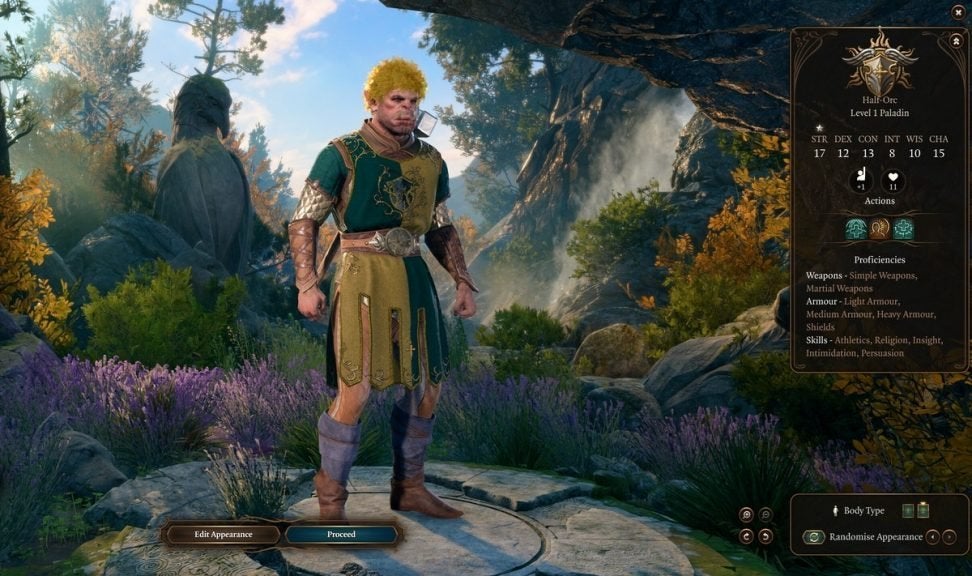
- Primary Ability: Strength
- Recommended Races: Human, Shield Dwarf, Zariel Tiefling
- Weapon Proficiencies: Martial Weapons, Simple Weapons
- Armor Proficiencies: Light Armor, Medium Armor, Heavy Armor, Shields
- Subclasses: Oath of the Ancients, Oath of Devotion, Oathbreaker, Oath of Vengeance
A roleplaying staple, Paladins are lights in the darkness. Sworn to serve justice and righteousness, Paladins are melee-spellcaster hybrids that excel at healing and buffing allies while dealing divine damage to enemies. Players interested in the lore of Baldur’s Gate 3 will also enjoy this class outside of battle, as Paladins must often deal with dark temptations as they struggle to remain true to their cause. They immediately choose a subclass, as this represents the Oath they’ve sworn to uphold.
Paladins dedicating themselves to the Oath of the Ancients swear to fight on the side of light to preserve life. Favored by nature, these warriors are able to use Healing Radiance to heal themselves and nearby allies, along with Nature’s Wrath, which renders your target unable to move. These Paladins can also speak to animals.
The Oath of Devotion conjures images of a perfect knight in shining armor coming to save the day from fearsome foes. A good choice for a frontline tank, this subclass unlocks the Sacred Weapon Channel Oath, which imbues your weapon with radiant energy, making it more likely to hit. It also unlocks Turn the Unholy, which allows you to Turn nearby fiends and undead.
Paladins taking the Oath of Vengeance swear to punish sinners and right wrongs. These warriors are effective against single targets, quickly closing the gap by hindering enemy movement while buffing their own.
If you fail to uphold the tenets of the above subclasses, the Oathbreaker Knight will appear in your camp. He gives you the option to change your subclass to Oathbreaker, which allows you to wield necrotic energy to twist and maim your foes. You can also use Dreadful Aspect, causing all nearby enemies to flee in fear.
Ranger
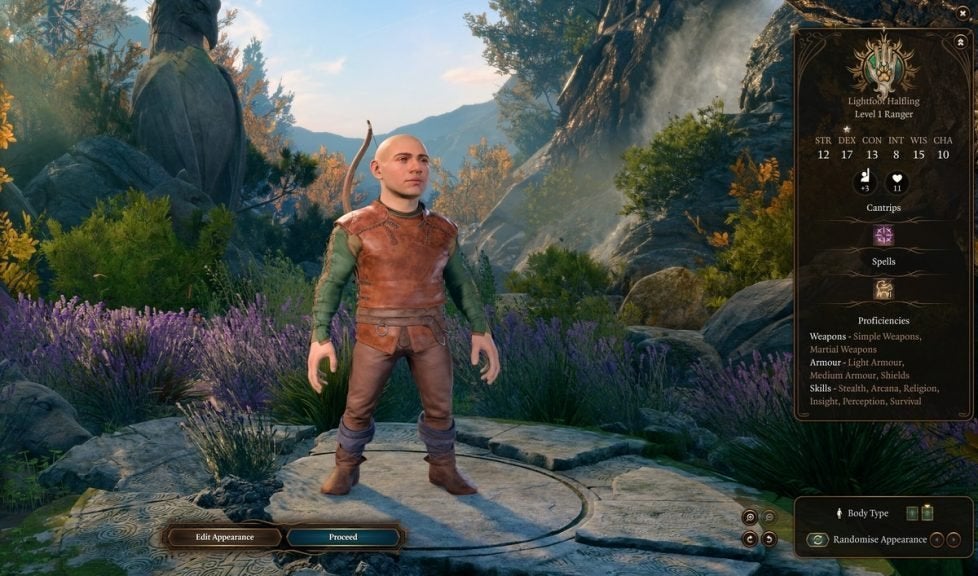
- Primary Ability: Dexterity
- Recommended Races: Human, Strongheart Halfling, Wood Elf
- Weapon Proficiencies: Martial Weapons, Simple Weapons
- Armor Proficiencies: Light Armor, Medium Armor, Shields
- Subclasses: Beast Master (Level 3), Gloom Stalker (Level 3), Hunter (Level 3)
Rangers boast a strong connection to the natural world and are unparalleled scouts and trackers. In battle, Rangers wield powerful spells that give them a large advantage over single targets. Rangers also enjoy many passive attack bonuses. While creating a Ranger, players need to choose a Favored Enemy. This choice grants spells, proficiencies, or bonuses—and additional Favored Enemies can be chosen at Level 6 and Level 10.
The Beast Master subclass allows you to bind yourself to an animal companion, which can have an influence both in and out of battle. Your companion can be a Boar, Wolf, Bear, Wolf Spider, or Dire Raven, with each having access to its own unique skills and strengths. These beasts will grow stronger as you do, slowly gaining access to new abilities.
Similar to Assassins, Gloom Stalkers prefer to ambush their prey, requiring high initiative rolls to start combat. They are capable of becoming invisible despite being in the thick of battle. Given their proclivity for the shadows, they are also gifted with more powerful Darkvision.
The versatile Hunter subclass grants a number of passives at the start of a battle. Unlocking a variety of AoE attacks at later levels, these fighter-spellcasters deal guaranteed damage with Colossus Slayer and boast some tough defensive tactics.
Rogue
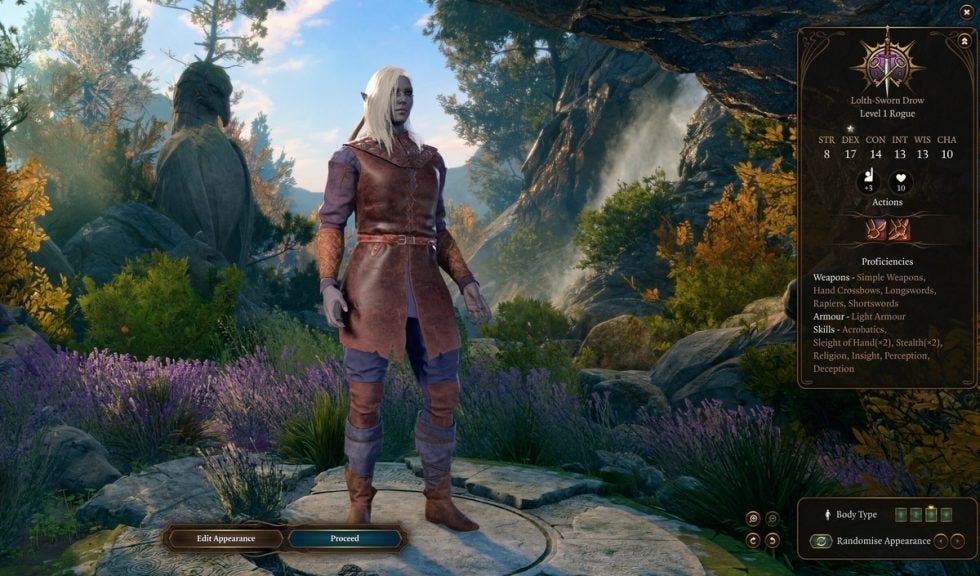
- Primary Ability: Dexterity
- Recommended Races: Drow, High Elf, Human, Wood Half-Elf
- Weapon Proficiencies: Hand Crossbows, Longswords, Rapiers, Shortswords, Simple Weapons
- Armor Proficiencies: Light Armor
- Subclasses: Arcane Trickster (Level 3), Assassin (Level 3), Thief (Level 3)
Rogues are experts at stealth and exploiting enemy weaknesses from the shadows. Outside of battle, this class is particularly helpful: they can disarm traps and open tricky locks with a flick of their wrist. During Character Creation, Rogues can grant Expertise to a Skill, meaning that you’ll get larger bonuses during Skill Checks. All in all, enemies will have a tough time landing a hit on you.
Players choosing the Arcane Trickster subclass can utilize spells capable of charming, terrorizing, or blinding their foes. You’ll be able to select new spells at Levels 3, 4, 7, 8, 10, and 11, granting you 4 Cantrips and 8 Spells in total. Particularly useful is the Magical Ambush passive, which puts enemies at a disadvantage if you cast a spell at them while hidden.
Assassins take aim at a single target, dealing massive damage if ambushing their enemy successfully. Skilled players able to surprise their enemies before the start of battle will be rewarded with an Advantage on Attack Rolls and guaranteed Critical Hits.
The Thief subclass utilizes the best skills on the Dexterity tree, gaining reduced fall damage and extra bonus actions in battle. At Level 9, Thieves unlock Supreme Sneak, allowing them to turn invisible for 10 entire turns.
Sorcerer
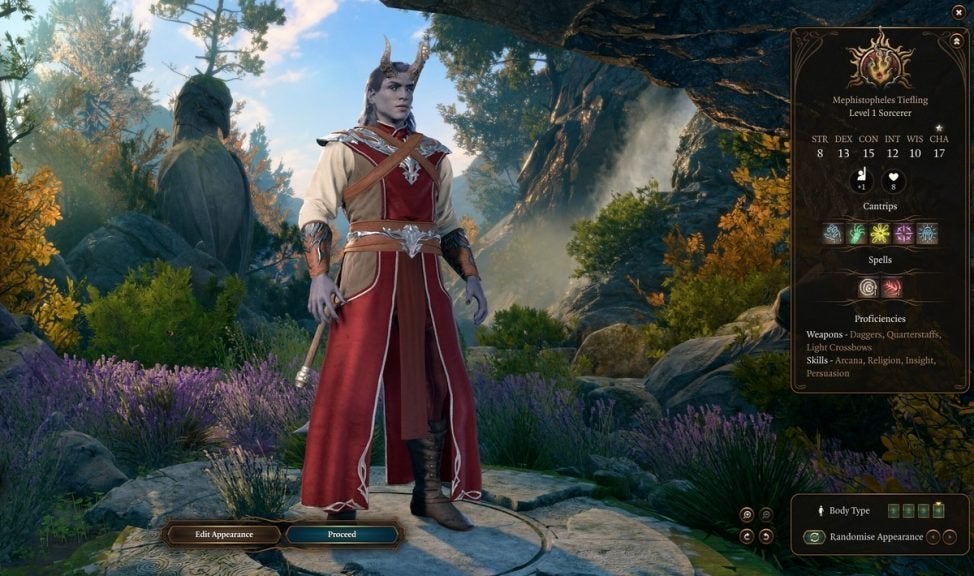
- Primary Ability: Charisma
- Recommended Races: Asmodeus Tiefling, Elf, Half-Elf, Human
- Weapon Proficiencies: Daggers, Light Crossbows, Quarterstaffs
- Armor Proficiencies: None
- Subclasses: Draconic Bloodline, Storm Sorcery, Wild Magic
Boasting an innate connection to the Arcane, Sorcerers are master spellcasters capable of lighting up the battlefield with magic. You’ll choose your Sorcerous Origin during the Character Creation process, and this decision dictates how effective particular spell effects are in battle. Your origin can also add extra affinities and resistances.
Sorcerers with a Draconic Bloodline tap into power from their ancient dragon ancestors, buffing their spells based on a particular element that can be chosen during Character Creation. At higher levels, they’re even able to fly, soaring around the battlefield with untold ease.
A Sorcerer with a background in Storm Sorcery draws their power from mighty tempests, dealing major damage and boasting a considerable arsenal from the start. At Level 6, they unlock five spells simultaneously, including Call Lightning, Sleet Storm, and Thunderwave.
Wild Magic is all about chaos, and these Sorcerers are prone to succumb to random surges that can impact both friends and foes alike. These magical surges can be positive or negative, making this a difficult subclass to master. If you’re a fan of unpredictability, this can be a fun choice.
Warlock
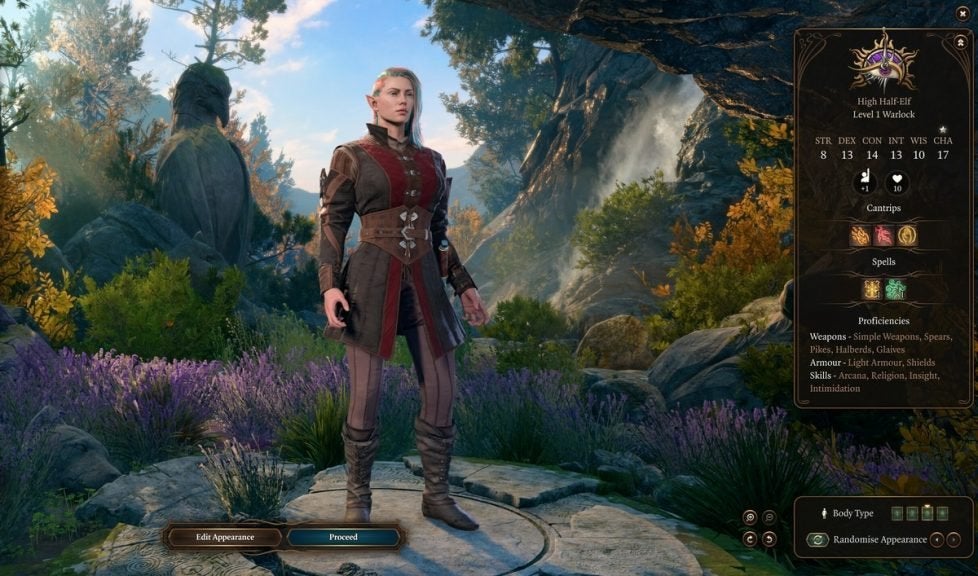
- Primary Ability: Charisma
- Recommended Races: Asmodeus Tiefling, Drow, Half-Elf, Human
- Weapon Proficiencies: Simple Weapons
- Armor Proficiencies: Light Armor
- Subclasses: Archfey, The Fiend, The Great Old One
While Sorcerers have innate magic flowing through their veins, Warlocks gain their spellcasting abilities through a pact made with an Otherworldly Patron of the Realms. You’ll choose this Patron during Character Creation. Although they have fewer spell slots, Warlocks are powerful magic users that can do major damage for a relatively low cost.
If you formed a pact with an Archfey, you’ll see a major boost to your character’s survivability. This subclass allows you to inflict painful status effects that make you impossible to attack. You can also put your enemies to sleep, frighten them away, or avoid them by becoming invisible yourself.
Warlocks in service to the Fiend focus on destruction and corruption while also boasting resistance to a single type of damage and bonus HP based on Charisma. The Dark One’s Own Luck feature adds a 1d10 to any ability check, allowing you to sail through the game with ease.
Serving the Great Old One as a Warlock grants passive features useful for inflicting damage on your enemy’s mind via Psychic damage. By utilizing blessings granted by a powerful eldritch being, many of this subclass’s effects are based on lucky rolls. If you like being a slave to RNG, why not give this one a try?
Wizard
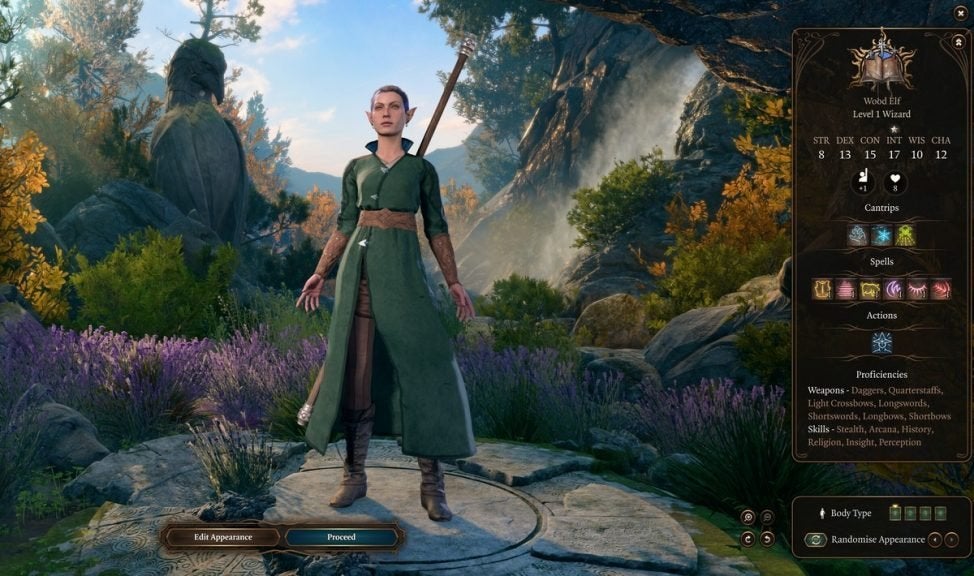
- Primary Ability: Intelligence
- Recommended Races: Drow, Half-Elf, High Elf, Mephistopheles Tiefling
- Weapon Proficiencies: Daggers, Light Crossbows, Quarterstaffs
- Armor Proficiencies: None
- Subclasses: Abjuration (Level 2), Conjuration (Level 2), Divination (Level 2), Enchantment (Level 2), Evocation (Level 2), Illusion (Level 2), Necromancy (Level 2), Transmutation (Level 2)
When choosing to become a Wizard, you’ll also need to decide which school of magic you attended. Rather than relying on leveling to learn new spells, these magic users can learn new abilities by transcribing the Magic Scrolls they collect out in the world. With the largest magical arsenal in the game, Wizards are versatile damage dealers and party boosters that will decide on their Arcane Tradition when reaching Level 2.
Abjuration is all about banishing enemies, summoning protective wards, and nullifying incoming magic. Those who want to focus on defense would do well choosing this Arcane Tradition. At Level 6, you learn the Projected Ward reaction, which can be used to shield an ally from incoming damage.
Wizards focusing on Conjuration are able to summon both creatures and objects to harm and disorient foes. These spellcasters can disrupt enemy movement and even teleport to an unoccupied space on the battlefield after reaching Level 6.
Players who choose the school of Divination as their focus are able to influence the outcome of certain dice rolls, skewing things to work in their favor. This can mean inflicting Disadvantage on enemies, granting Advantage to yourself, or even replacing the rolled value of a dice roll itself.
Enchantment is all about Charming one’s foes, making them vulnerable to damage, and turning them against their allies. At Level 10, these powerful Wizards are able to use the Split Enchantment passive, targeting an extra creature when casting spells typically targeting a single foe.
A focus on Evocation gives access to elemental AoE attacks that are some of the most powerful in the game. At Level 2, the Sculpt Spells passive unlocks, protecting your allies from damage as you wield your otherworldly power.
Illusion Wizards can use spells to confuse their foes, casting illusions of themselves to draw in enemies and make them vulnerable to damage. At Level 6, the See Invisibility class action makes it possible to see invisible creatures within a 9m radius, making exploration even more fun.
Necromancy lets you summon the undead on the battlefield—with these reanimated corpses raising even more thralls to aid them. Upon unlocking this subclass, you’ll gain access to the Grim Harvest passive feature, which will heal you when killing enemies with a spell.
Wizards focusing on Transmutation are able to grant themselves or others unique buffs useful for exploration, such as tripling jump distance or negating fall damage. At Level 10, Transmutation Wizards are able to fly by transforming into a Blue Jay.
The Best Classes in Baldur’s Gate 3 for New Players
With this mountain of classes and subclasses to choose from, those unfamiliar with D&D and previous entries to the Baldur’s Gate series may feel a little intimidated. When starting out, it’s best to choose a class without too many mechanics and choices to juggle.
For those players who want to prioritize physical strength, we’d recommend the Barbarian or Fighter classes.
When playing Barbarian, the only challenge new players may face is deciding when to tap into Rage, as it has limited use. Choosing armor can also be tough, but that isn’t a concern for Barbarians—as they get a bonus for not wearing any! Just jump into battle and start wailing on your foes. The Berserker subclass will also keep things simple.
Fighters have a little more flexibility on the battlefield, allowing for either a power-centric build or a more stealthy approach. The Champion subclass makes it easy to focus on dealing damage while avoiding any overcomplicated mechanics.
New players wanting a more magic-centric experience may want to choose either Cleric or Druid.
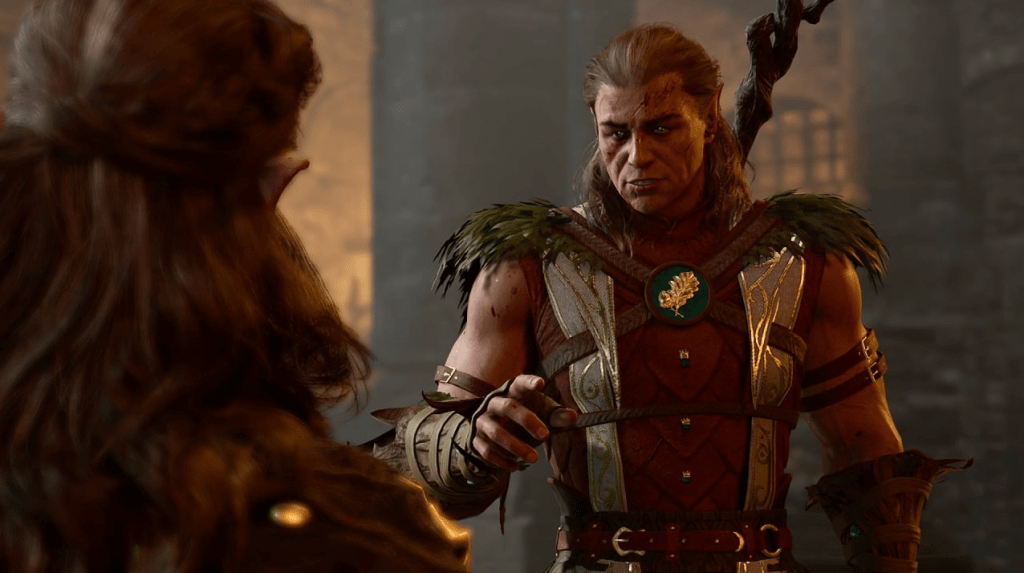
Choosing to play a Cleric with a Life Domain focus will ensure that you can always heal yourself and your party. Additionally, you can always shift into a more combat-heavy role by changing your active spells. This is also a great class for players more interested in the game’s story, as Clerics enjoy tons of unique dialogue and interactions throughout their travels.
Druids—particularly those attuned to the Circle of the Moon subclass—can shield themselves from damage by transforming into an animal, giving them a separate HP pool. Attacking your enemies as a massive bear also feels just as good as you’d think.
Even with some direction, choosing your class and subclass in Baldur’s Gate 3 can be overwhelming. It may take some time and experimentation to find the build that’s perfect for your play style. When in doubt, go with your gut. With the help of the spooky NPC Withers, you can always change your mind during your quest through Faerun.


